by Valerie Mendez Stansly | Aug 23, 2024
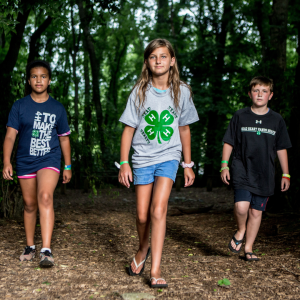 Every fall, as the North Florida Fair rolls into Tallahassee, 4-H members eagerly anticipate 4-H Day, a special day filled with excitement beyond the usual fair food and rides. This annual event offers 4-H participants a chance to dive into a range of contests and activities, with one of the highlights being the Wildlife Ecology contest. During this competition, young people get the opportunity to test their knowledge and skills by identifying various forest trees and wildlife, making it a fantastic blend of fun and learning.
Every fall, as the North Florida Fair rolls into Tallahassee, 4-H members eagerly anticipate 4-H Day, a special day filled with excitement beyond the usual fair food and rides. This annual event offers 4-H participants a chance to dive into a range of contests and activities, with one of the highlights being the Wildlife Ecology contest. During this competition, young people get the opportunity to test their knowledge and skills by identifying various forest trees and wildlife, making it a fantastic blend of fun and learning.
The Contest
The 4-H Wildlife Judging Contest is a showcase of both individual and team talents. All youth ages 8-18 can participate as individual competitors. Participants from the same county can also be organized into teams of 3 or 4, and compete at Junior, Intermediate, and Senior levels based on age. At the end of the contest, the scores from the top three team members are combined to determine the team’s overall performance.
The contest is divided into various stations, each focusing on different aspects of wildlife and forest ecology. Three main topics covered during the fall contest are:
- Trees
- Mammals
- Birds, Reptiles, and Amphibians
Beyond the Contest
The 4-H Wildlife Judging Contest is much more than a competitive event; it’s a platform for essential life skill development. Preparation for and participation in the contest teach youth valuable lessons beyond academic knowledge of Florida’s ecology:
- Critical Thinking: Evaluating plants and wildlife involves using what youth know to make smart decisions. They have to consider various details, like the characteristics of different species and their role in the environment in order to properly identify the plant or animal species. This hands-on approach helps youth develop better problem-solving skills and feel more confident in their decision-making.
- Teamwork and Leadership: The contest encourages students to work together, which helps them learn how to communicate and support each other effectively. They also get a chance to take on leadership roles, guiding their team and making sure younger members understand the subject matter during preparation meetings. These experiences helps youth build important skills for working well with others in school and in their future careers.
- Dedication and Perseverance: Preparing for the contest takes a lot of hard work and commitment, as youth need to study and practice regularly. This process teaches them the value of persistence and dedication, which are important for achieving success in any area of life. The skills they develop through this effort can help them tackle challenges and stay focused on their goals.
Starting a Wildlife Ecology Club
If the opportunities offered by the 4-H Wildlife Judging Contest has inspired you, starting a Wildlife Ecology Club at your school or community center is a great way to engage more youth in environmental education. These clubs are wonderful way of integrating various age groups and skill levels, allowing members to work both independently and collaboratively. Inviting special speakers such as extension agents, foresters, and rangers can introduce youth to meaningful careers in forestry and wildlife conservation. In addition to club meetings, monthly hikes can provide hands-on experience, allowing kids to explore the outdoors while refining their identification skills.
Your local county 4-H agent and staff are the greatest resource on how you could get started in your area. Many counties in Florida already boast 4-H community clubs dedicated to wildlife and forest ecology that you can volunteer or meet to shadow before starting your own club. In addition, the Florida 4-H Forest Ecology page offers a wealth of information regarding the annual statewide and national Forest Ecology Contest that is held each spring.
Conclusion
The 4-H Wildlife Judging Contest at the North Florida Fair exemplifies the intersection of competition and education, offering a dynamic platform for youth to deepen their understanding of Florida’s forests and wildlife. Beyond the competition, the skills and experiences gained through participation are invaluable, preparing young individuals for future challenges and opportunities. Whether through participating or starting a new club, engaging with Florida’s wildlife and ecology fosters a lifelong appreciation for the natural world and equips youth with essential life skills.
by Valerie Mendez Stansly | Mar 28, 2024
As we continue with part two of our series ‘Planning a Safe and Engaging Paddling Adventure for Youth,’ our goal is to highlight the key elements that make these excursions both memorable and educational. You will be introduced to the essentials of group dynamics, communication strategies, and incorporating educational components to your trip. Whether you’re planning a day trip or a multi-day camp, the information in this blog will help you navigate the challenges and delights of introducing young paddlers to the wonders of the great outdoors.
Paddling is a Group Activity
A successful paddling trip depends greatly on strong group dynamics and clear communication. Prior to getting on the water, it’s essential to conduct a thorough on-land training session that covers the basics of paddling, maintaining balance, and methods for recovering from a capsize. Turning these drills into interactive and enjoyable activities can greatly alleviate any nervousness and boost the confidence of your youth participants. For those organizing multi-day camps, scheduling this training a day in advance can be particularly beneficial—the more familiar youth become with these practices, the better.
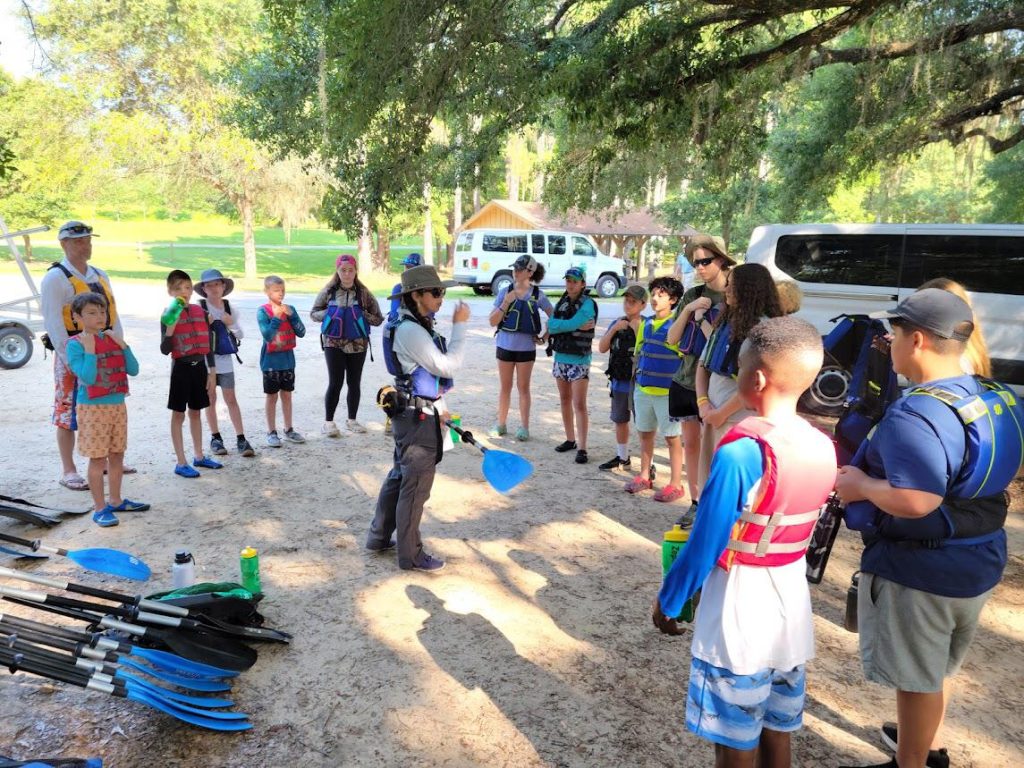
A successful paddling trip fosters solid group dynamics, clear communication, and teachers essential on-land training that covers paddling fundamentals, balance maintenance, and capsize recovery techniques.
Before setting out, it’s important that designated adult volunteers take on the specific roles, such as the lead and sweep, to maintain order and ensure the group’s safety throughout the adventure. The lead is responsible for navigating the route, monitoring for hazards, being mindful of other waterway users, and setting a pace that accommodates the entire group. The sweep boat, positioned at the end of the group, ensures that no one falls behind. This position requires experience with rescue situations, the capability to offer aid during capsizes or emergencies, and typically includes the responsibility of carrying a first aid kit along with having certifications in first aid, and CPR.
Effective and clear communication is essential when on the water. All paddlers should stay within earshot of each other to facilitate this. However, if distance makes verbal communication challenging, hand, paddle, and whistle signals become crucial tools for conveying messages. For instance, holding a paddle horizontally above your head signals others to stop paddling. Raising your arms vertically signifies an all-clear or prompts others to proceed. Waving your paddle overhead indicates a need for assistance in emergencies. To direct paddlers, use your paddle to point in the intended direction of travel, avoiding using it to point out hazards.
Whistle signals also play a key role in communication:
- One whistle blast calls for attention, urging the group to stop and wait for further instructions.
- Two blasts instruct paddlers to stop and remain in their current location.
- Three blasts signal an emergency, indicating that help is needed.
By creating clear communication among experienced adults, the trip not only becomes safer but also serves as an opportunity to demonstrate responsibility and leadership to youth on the trip. This structure provides a secure environment where youth can focus on refining their paddling skills and fully engage in the educational aspects of the activity. Modeling teamwork within the adults fosters a sense of unity throughout the team, enabling everyone to navigate challenges more effectively.
In case of a Capsize
When someone capsizes, it’s essential to remember your rescue priorities. The safety of people is always the most important. First, make sure everyone is safe. Then, collect boats and paddles. After securing the larger items, you can retrieve smaller gear like water bottles and dry bags.
If you’re the rescuer, it’s crucial to stay calm and control your boat to avoid becoming a casualty yourself. Ask for help if needed, giving clear instructions to the victim or other group members. If you’re witnessing a capsize, sometimes the best action is to stay clear unless the rescuer calls for assistance. If asked to help, follow their instructions while keeping yourself and your boat under control.
As a potential rescuer, remember the sequence talk – reach – throw – paddle – go.
- Talk: Start by getting the attention of the capsized paddler using your voice, whistle, or another sound device. Often, simply talking them through staying calm and performing a self-rescue is enough.
- Reach: If more than verbal guidance is needed, use the reach method. Extend your paddle or arm to help. Guide them to the front of your kayak for safety, avoiding having them hold onto the side, which could destabilize your kayak.
- Throw: When the capsized paddler is too far for a reach, throw them a rope or a life float they can grab onto.
- Paddle: If neither talking, reaching, nor throwing works, paddle close enough to them so they can be safely pulled to safety using the reach or throw method.
- Go: As a last resort, you may need to get into the water to assist, which involves significant risk. Ensure bystanders are calling for help while you swim to the capsized paddler’s aid.
This approach ensures everyone knows their role in a capsize situation, prioritizing safety and effective rescue techniques.
Outdoor Education and Stewardship
Enhance your paddling journey by turning it into a comprehensive educational experience, focusing on the local ecosystem and conservation initiatives. By immersing participants in the surrounding natural environment, you deepen their connection and commitment to environmental stewardship.
Teaching and practicing Leave No Trace principles is key to fostering respect for our natural surroundings. Paddling leaders play a crucial role in emphasizing the importance of minimizing our environmental impact, showing consideration for wildlife, and preserving the natural beauty of our waterways. Instilling these values in young paddlers helps them understand the critical role they play in conservation efforts and encourages them to engage in responsible outdoor behaviors well into adulthood.
Reflection
Incorporating a debrief, or post-trip reflection session, into your paddling adventure is an excellent way to incorporate principles of experiential learning, which values learning through action and reflection. After your trip, taking time for a debrief enables participants to express their thoughts on the activity, confront challenges encountered, and share new insights. Purposeful reflection is essential to the experiential learning process, helping learners to internalize their experiences and apply their insights in future contexts.
Debriefing among adults is also important. Scenarios encountered during the trip may highlight potential opportunities where additional training from certified instructors to improve paddling skills and safety knowledge is needed.
Conclusion
Embarking on a paddling adventure with youth offers more than just a day on the water; it’s an opportunity to foster teamwork, respect for nature, and a commitment to environmental stewardship through experiential learning. By incorporating safety, education, and reflection, we not only ensure a memorable and enriching experience but also instill important values and skills that youth will carry with them long after the trip ends.
Resources:
Want to learn more? Check out Paddle TV on YouTube which has made great videos in partnership with the American Canoe Association (ACA) by following the link: https://americancanoe.org/education/youth-paddling-development/educational-videos/
Consider using the Paddle Safe Paddle Smart (PS2) curriculum that has been created by ACA when implementing a paddling component during day camps or workshops.
Paddling Trip Checklist for Leaders
This checklist serves as a foundational tool for leaders to ensure that every aspect of the paddling trip is accounted for, from safety to environmental education. By following this guide and utilizing the checklist, leaders can provide a safe, enjoyable, and enriching paddling experience that youth participants will remember for years to come.
by Valerie Mendez Stansly | Mar 21, 2024
Setting off on a paddling adventure with youth, whether it involves canoeing, kayaking, or stand-up paddleboarding (SUP), offers a wonderful opportunity for them to get active, connect with the outdoors, and learn the value of teamwork. These activities can leave a lasting impression on the young people involved, fostering feelings of accomplishment, resilience, and fellowship. However, the responsibility on the adults leading these trips is significant. Ensuring a safe, educational, and enjoyable experience requires meticulous planning, a focus on safety, and a commitment to engaging each participant. Through this blog series, you will be provided with the insights and tools necessary to organize a successful paddling event for youth.
Securing Kayaks
Safety is the foundation of any successful paddling adventure, especially when involving young people. A critical, yet often overlooked, aspect of this safety is the secure transportation of your kayaks. Begin by firmly attaching your kayaks to your trailer using suitable straps. Before hitting the road, double-check that the straps are tightly fastened, the ends are securely tied off, and the kayak doesn’t move when you gently rock it.
When loading a kayak, always position the straps in advance. It’s a team effort to safely lift the kayak by its bow (front) and stern (back) handles—remembering to bend at the knees to protect your back. Once the kayak is evenly placed on the trailer’s crossbars, secure it properly by using the appropriate ties. Although ratcheting straps are commonly used, they can potentially damage your kayak due to excessive pressure. As an alternative, the use of buckle bumper straps offers a safe and user-friendly solution for both novices and experienced paddlers alike. Ensuring your kayaks are safely secured not only protects your equipment but also ensures the safety of everyone on the road.
Planning is Essential – Crafting a Float Plan
The backbone of a smooth paddling adventure is a detailed float plan. This document should outline your route, expected weather conditions, participant list with emergency contacts, and a timeline of the trip. Utilizing resources such as the Coast Guard Float Plan Central website ensures you don’t miss any critical planning steps. Your float plan should include not only the basics but also specific details such as the equipment each person will bring, health forms, expected departure and return times, access points, and the driving route. It’s also vital to assess and document the day’s weather, tides, water flow, and temperature, alongside local regulations, necessary permits, and the nearest emergency services and outfitters.
In addition to creating a comprehensive float plan, it’s essential to pack necessary items like water, snacks, sunscreen, and first-aid supplies, while encouraging lightweight packing to minimize the physical load on paddlers. Ensure that agents and other adults in charge involved are well-informed about the float plan, current and forecasted weather conditions, and the personal skills and comfort levels within the group.
Remember, the float plan is not just a list; it’s a snapshot of your group’s capabilities, equipment, and safety resources. Items not directly related to trip planning and participant safety should be recorded separately. Always leave the float plan with someone on shore who is familiar with the trip details, participants, and local area. This person’s responsibility is to alert local authorities should the group not return as scheduled. Typically, float plans are best entrusted to an agent and/or county extension director.
When you are out on the water, pay close attention to changing weather conditions. If the weather gets challenging, ensure your group stays together and maintains steady communication. In the case of unexpected thunder, lightning, heavy rain, or strong wind, find a protected area on land for the group to escape the elements. If the group gets off the water, be sure that boats or boards are far away from the water’s edge. Make sure to take all paddles and any food, water, and personal gear are with youth.
Choosing the Right Gear
Personal gear and preparedness are crucial for the success of your paddling trip. When choosing a paddling outfit, prioritize versatility, durability, and protection against cold, and wet conditions. Here are some key guidelines:
- Personal Flotation Device (PFD): Always wear a PFD while on the water. Ensure it fits snugly without riding up over your face or head. If adjustments are needed, do so safely onshore.
- Temperature Considerations: Youth and adults should dress for potential immersion. Hypothermia, a dangerous drop in body temperature, can occur in water temperatures as “warm” as 70 degrees Fahrenheit, according to U.S. Coast Guard. Conversely, hyperthermia results from overheating, often due to hot, humid conditions. Dressing in layers will help adjust for body temperature changes during the trip.
- Sun Protection: Applying sunscreen is critical for preventing sunburn and overheating, even on cloudy days. Due to the reflective nature of water, apply sunscreen often. Mineral sunscreen, with zinc oxide or titanium dioxide, forms a barrier against UV rays with a reduce risk of irritation or allergic reaction and is favored by many paddlers.
- Avoid cotton and restrictive clothing: Steer clear of cotton clothing such as jeans and hoodies, which retain water when wet. Instead choose garments made from quick-drying, moisture-wicking synthetics, or wool, which provide insulation even when wet. Fortunately, outfitting yourself appropriately doesn’t have to break the bank—many of these items can be readily found at affordable prices in secondhand stores like Goodwill.
By following safety guidelines and preparing with the right gear, paddlers can enjoy a safe and comfortable experience on the water, ready to face varying temperatures and conditions with confidence. In the next blog, we will discuss group management and safety considerations to take while on the water.
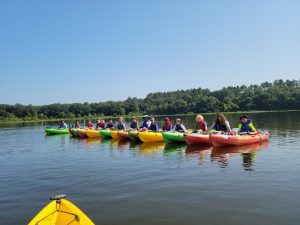
Introducing youth to the joys of paddling can create unforgettable memories that last a lifetime. At the same time, it’s crucial that we, as adults, prioritize their safety above all.
Resources:
Want to learn more? Check out Paddle TV on YouTube which has made great videos in partnership with the American Canoe Association (ACA) by following this link: https://americancanoe.org/education/youth-paddling-development/educational-videos/
Consider using the Paddle Safe Paddle Smart (PS2) curriculum that has been created by ACA when implementing a paddling component during day camps or workshops.
by Valerie Mendez Stansly | Feb 5, 2024
From Brushstrokes to Life Skills: The Spark of Art
Art has always been a medium of expression. It allows emotions, ideas, and stories to be shared visually, bridging gaps where words sometimes fall short. For the young minds of today’s world, art offers a plethora of benefits that extend far beyond the canvas or sculpture stand. Art is not just about creating beautiful pieces; it’s a potent tool that fosters communication, sharpens cognitive skills, and broadens horizons.
Improving Focus and Creativity Through Art
Art is a unique medium that demands both concentration and imagination. As youth experiment with colors, shapes, and techniques, they cultivate a creative mindset. The process of creating a finished art piece takes time, allowing youth to learn how to stay motivated through a long-term project. Whether creating or analyzing art, sustained attention to detail is required which helps youth to enhance focus. This interplay between deep concentration and imaginative exploration through art not only hones specific artistic skills but also fosters a broader capacity for creative thinking in various life scenarios.
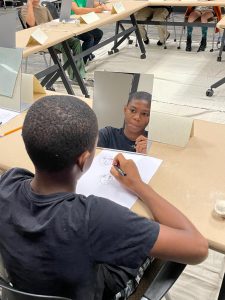
Photo 1: Activities such as blind contour requires intense observation. This process trains youth to focus deeply and observe minute details, strengthening their attention span and observational skills.
Enhancing Communication Skills and Critical Thinking
Engaging with art serves as a dual exercise in communication and analysis for youth. Although art gives youth a medium to express nuanced emotions and ideas visually, often conveying what words might struggle to capture, it can also increase their communication skills by increasing their visual literacy. Teaching the fundamentals such as the elements of art and principles of design gives youth the vocabulary needed to dissect art verbally. During this process, young people grapple with interpretations and the underlying intentions of artists, honing their critical thinking. In today’s visually charged world, recognizing these art elements helps youth decode and discern underlying intentions, making them more informed consumers of the visual content they receive in the form of ads and social media.

Photo 2: At this art exhibit, young artists not only display their creations but practice their communication skills.
Promoting Appreciation of Differences
Art introduces youth to a world that spans cultures and eras. Through engaging with various artists and forms of art, they gain insights into different values, beliefs, and narratives. The subjectivity of art teaches them that multiple valid perspectives can coexist, each shaped by individual experiences. As young artists create, they learn to value their unique voices and respect others’ individuality. Learning these skills helps to prepare youth to navigate the world with understanding and empathy.
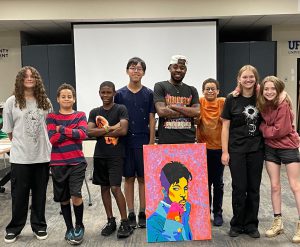
Photo 3: Art underscores the significance of individual expression and the beauty of varied perspectives.
How to Start an Art Program
Starting an art program for youth begins with the basics. Introducing them to the elements of art—such as line, shape, and color—and intertwining these with the principles of design, like balance and contrast, sets a strong foundation for understanding and creating diverse art forms. With these foundational skills in place, activities like group art critiques and art exhibits become both educational and enriching. For example, activities such as art journaling, reinforce newfound skills and perspectives, allowing a dynamic, hands-on exploration of the world of art that can be done in a workshop, club, or camp setting, but also at home. The National 4-H curriculum website offers many curriculum resources, alongside galleries and museums. Aside from being great for field trips, many local galleries offer youth year-round youth activities.
Fostering Art Skills through Florida 4-H
In 4-H, recognition of our youth members is an important step in creating a sense of belonging and developing positive self-esteem. A dedicated art program can provide youth with the opportunity to share their knowledge and be recognized for mastery gained in art through various Florida 4-H events. Below are some of these events:
- Share the Fun in our County/District Showcase and 4-H University.
- Florida 4-H Graphic Design and Photography Contests
- Florida 4-H Holiday Card Contest
- The Insect Art Contest (Insectathon)
Conclusion
Incorporating art into the lives of young people provides multifaceted benefits. From enhancing communication and critical thinking to fostering a deep appreciation for the vast spectrum of human experiences. Moreover, starting an art program in your county not only equips youth with technical competencies, but also instills values of empathy, understanding, and open-mindedness. As our society grows more interconnected, cultivating these qualities becomes an invaluable investment in our youth’s future.
We would like to thank BLICK Art Materials and the Artists League of the Big Bend for generously supporting the art program in Leon County 4-H. For more information about upcoming art workshops with Leon County 4-H, visit the UF IFAS Extension Leon County 4-H Facebook page or contact the Leon County 4-H Team at leon4h@ifas.ufl.edu.
Resources:
National Gallery of Art: https://www.nga.gov/learn/learningresources.html
National 4-H Curriculum for Visual and Creative Arts: https://shop4-h.org/collections/creative-arts-curriculum
by Valerie Mendez Stansly | Nov 17, 2023
Agriculture plays an important role in our society, yet a noticeable gap in understanding and engaging with this sector is evident among youth. Often, this disconnect stems from misconceptions about agriculture and the vast career opportunities it offers. Addressing these challenges requires long-term educational efforts that provide youth with hands-on experiences in the form of field excursions to increase interest and participation in Agriscience topics. The Ag Adventures program, an annual venture between UF/IFAS North Florida Research and Education Center (NFREC) and Florida 4-H, was created in response to this need. It aims to immerse students in the diverse and rich world of agriculture through experiential learning.

Ag Adventures connects youth from urban and rural areas to a large-scale farming research center, offering a firsthand look at agriscience topics in action.
Program Overview
For years, Ag Adventures has been actively engaging 4th and 5th graders from counties across the Panhandle. This program introduces students to several key subfields in agriculture, with an emphasis on sustainability:
- Soil Science: Students learn about the critical role of soil in natural ecosystems and agriculture. Hands-on experiences, such as exploring a soil pit, help youth gain a deeper understanding of soil science topics.
- Agricultural Technology: Students explore the latest innovations in precision agriculture, including drones and sensor technology, and their role in promoting sustainability and economic growth.
- Entomology: Focusing on the vital role of pollinators, students learn about the impact of insects on the ecosystem and our food supply. Field activities, like insect collecting, offer practical understanding of the importance of these animals and the need to protect them.
- Agronomy: By learning about crops such as corn, cotton, and peanuts, students gain insights into the economic and historical significance of agriculture in North Florida. Through this section, researchers and agents are able to showcases the diversity and complexity of plant science in a tangible way.
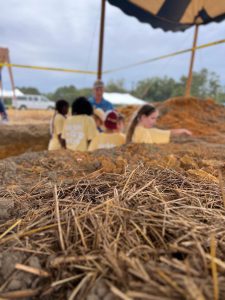
Students explore a soil pit, uncovering the hidden wonders of soil science and gaining hands-on insight into soil formation in our region.
Benefits of Field Excursions
Engagement in programs like Ag Adventures offers a multitude of benefits, equipping students with valuable insights and experiences that go beyond the traditional classroom. Such field excursions are important for:
- Strengthening STEM Appreciation: By contextualizing STEM concepts within the framework of agriculture, Ag Adventures bridges the gap between classroom learning and its practical applications. This approach not only enriches students’ understanding of STEM but can also spark their curiosity about agriscience.
- Facilitating Career Exploration: Ag Adventures provides a platform for youth to explore various careers in STEM. Through interactive experiences and exposure to academic pathways, the program demystifies agriculture, making it more accessible and relatable. This engagement broadens their career horizons and helps them envision a future where they can apply their learning in diverse ways.
- Bridging the Urban-Rural Divide: Ag Adventures offers youth from all backgrounds a chance to experience large-scale farming firsthand. By connecting youth directly with the source of their food, the program fosters a deeper appreciation for agricultural contributions and the interdependence between urban and rural communities.

Ag Adventures enables young learners to engage with faculty members and discover cutting-edge agricultural research. For example, NFREC researchers demonstrate the use of thermal imaging technology to detect drought stress in crops, showcasing practical applications of science in farming.
Conclusion
The Ag Adventures program enhances the educational experience of 4th and 5th graders by merging classroom learning with real-world agricultural practices. This initiative by UF/IFAS Extension deepens their appreciation for STEM, opens new avenues for career exploration, and introduces them to the unique aspects of rural life and agriculture. We hope students develop a more comprehensive understanding of the world, laying the foundation for them to become informed and engaged members of society.
This program occurs annually in the fall. If you are interested in your school participating, please contact your local UF/IFAS Extension office.
References:
Behrendt, M., & Franklin, T. (2014). A review of research on school field trips and their value in education. International Journal of Environmental and Science Education, 9(3), 235-245.
Jean-Philippe, S., Richards, J., Gwinn, K., & Beyl, C. (2017). Urban youth perceptions of agriculture. Journal of Youth Development, 12(3). https://doi.org/10.5195/jyd.2017.497
 Every fall, as the North Florida Fair rolls into Tallahassee, 4-H members eagerly anticipate 4-H Day, a special day filled with excitement beyond the usual fair food and rides. This annual event offers 4-H participants a chance to dive into a range of contests and activities, with one of the highlights being the Wildlife Ecology contest. During this competition, young people get the opportunity to test their knowledge and skills by identifying various forest trees and wildlife, making it a fantastic blend of fun and learning.
Every fall, as the North Florida Fair rolls into Tallahassee, 4-H members eagerly anticipate 4-H Day, a special day filled with excitement beyond the usual fair food and rides. This annual event offers 4-H participants a chance to dive into a range of contests and activities, with one of the highlights being the Wildlife Ecology contest. During this competition, young people get the opportunity to test their knowledge and skills by identifying various forest trees and wildlife, making it a fantastic blend of fun and learning.







